|
It seems most
every old time rubber-powered free flight model has been converted by someone to
electric-powered radio control. The availability of motors and R/C airborne systems
weighing in the grams - or fraction thereof - is making R/C flight for even the
tiniest models possible. It would be interesting to see somebody convert these Matchbox
Fliers, which appeared in the April 1962 issue of American Modeler
magazine, to at least single-channel R/C using one of the nano-size radio
systems available today. Heck, there's probably a way to even mount
a camera to a model this small these days.
Matchbox Fliers More Fun Than a Barrel of "Sick" Comedians!
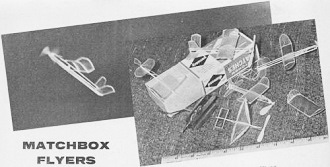 By Dick Everett By Dick Everett
Tiny airplanes that fit in a matchbox? Yes, and how they fly!
Rod Miller, a science teacher in Fresno, Calif., first heard about mini-models
from Don Martin. When Don was in military service in Germany, balsa was mighty scarce.
To conserve wood and still have contests, matchbox airplanes were devised.
In developing a series of miniature craft Rod started from scratch, employing
much initiative. Bamboo was one of his first materials, knowing he could split it
up very small. Tests on tissues for covering led to condenser paper. The need for
1/64" sheet balsa led to Swaney's hobby emporium in Long Beach and Micro-Dyne wood.
Rubber for power started with golf ball rubber, ended with Bungee cord from a boat
shop. Winding went from hand to hand-drill to a gear train from a broken toy.
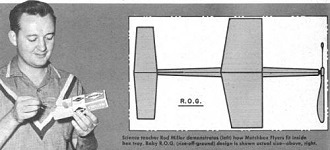 Science teacher Rod Miller demonstrates
(right) how Matchbox Fliers fit inside box tray. Baby R.O.G. (rise-off-ground) design
is shown actual size - below right. Science teacher Rod Miller demonstrates
(right) how Matchbox Fliers fit inside box tray. Baby R.O.G. (rise-off-ground) design
is shown actual size - below right.
These matchbox-size models really fly! - upper left. Squadron of contest jobs
are shown around the ever-present box; winder is from wind-up toy. Rubber-powered
planes look larger (above) when held by a small Miller. Design proposals sketched
are half-size here (nose plug at left is actual size). All appear full size on Hobby
Helpers' Group Plan # 462.
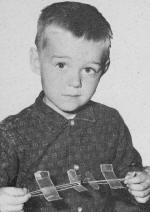 With conventional thrust bearings and shaft
housings, Rod figured a lot of power was being absorbed in metal washers, besides
metal was a little hard to work. Having been a chem major in college, he knew of
an excellent material with a very low co-efficient of friction - Teflon. He found
some used as a piston ring in an air compressor. With a cross section 1/16" x 1/8"
here, was enough for thousands of washers. They are cut 1/16" x 1/16" then pierced
with a pin. When cementing in place, it is necessary to completely cover the washer
since the adhesive will not stick to the Teflon. A word of caution - do not heat
this material! It gives off toxic gasses when very hot. With conventional thrust bearings and shaft
housings, Rod figured a lot of power was being absorbed in metal washers, besides
metal was a little hard to work. Having been a chem major in college, he knew of
an excellent material with a very low co-efficient of friction - Teflon. He found
some used as a piston ring in an air compressor. With a cross section 1/16" x 1/8"
here, was enough for thousands of washers. They are cut 1/16" x 1/16" then pierced
with a pin. When cementing in place, it is necessary to completely cover the washer
since the adhesive will not stick to the Teflon. A word of caution - do not heat
this material! It gives off toxic gasses when very hot.

Matchbox Flyer Baby R.O.G.

Matchbox Flyer Canard
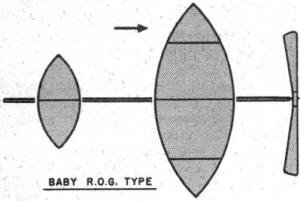
Matchbox Flyer Baby R.O.G. Type
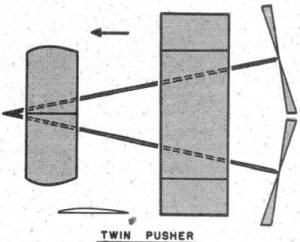
Matchbox Flyer Twin Pusher
Rules for this event are simple. The matchbox limits plane size. Ready-to-fly
model must fit within the box. The wing can't fold, the fuselage can't fold. Each
entry in its ready-to-fly state is put in the tray section of the box which is passed
thru the cover. To keep everything reasonably sane no hollow motor sticks or tail
booms are allowed. Micro-film would be okay and with this size model might be easier
to use than tissue.
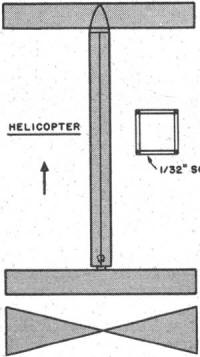 Just how big can a model be built? Inside
of tray measures 1 3/8" x 2 9/16" x 4 1/2". Take advantage of the diagonal and your
model can have a projected wingspan of 2 7/8". If you utilize the diagonal for length,
a model can be as much as 4 5/8" long. Just how big can a model be built? Inside
of tray measures 1 3/8" x 2 9/16" x 4 1/2". Take advantage of the diagonal and your
model can have a projected wingspan of 2 7/8". If you utilize the diagonal for length,
a model can be as much as 4 5/8" long.
Design-wise, imaginations can run wild. To provide sufficient wing area, aspect
ratios are fairly low, 1" chords are common. Is a lifting section desirable? Does
it do any good? So build both types! Horizontal tail area is quite large, usually
40 to 90% for a tractor. For a canard, we figure 100% would be practical. The fuselage
can be small "sticks," or built-up triangles with 1/32-sq or smaller longerons at
each corner, made long so plenty of rubber can be used. Propellers are 2 to 2 1/2
inches in diameter, almost equal to the wingspan. Two blades work better and are
lighter than a single blade with counterbalance.
No limitations on types! You should try twin pushers, canards, ROG's, tractors
and even helicopters. (Some sharp designer will probably clean up with a matchbox
helicopter.)
Contests can be held almost any place, even outdoors during calm weather. Auditoriums
too small for regular indoor models are perfect for matchbox miniatures. Club attendance
is stimulated by conducting "M.B." contests after meetings. It's an interesting
new phase in building. Have some fun...let yourself go...try Miller's matchbox miniatures.
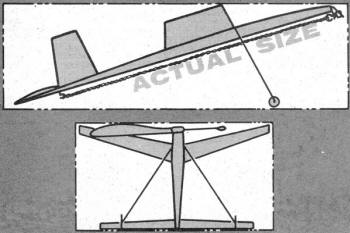
Notice:
The AMA Plans Service offers a
full-size version of many of the plans show here at a very reasonable cost. They
will scale the plans any size for you. It is always best to buy printed plans because
my scanner versions often have distortions that can cause parts to fit poorly. Purchasing
plans also help to support the operation of the
Academy of Model Aeronautics - the #1
advocate for model aviation throughout the world. If the AMA no longer has this
plan on file, I will be glad to send you my higher resolution version.
Try my Scale Calculator for
Model Airplane Plans.
Posted March 30, 2013
|